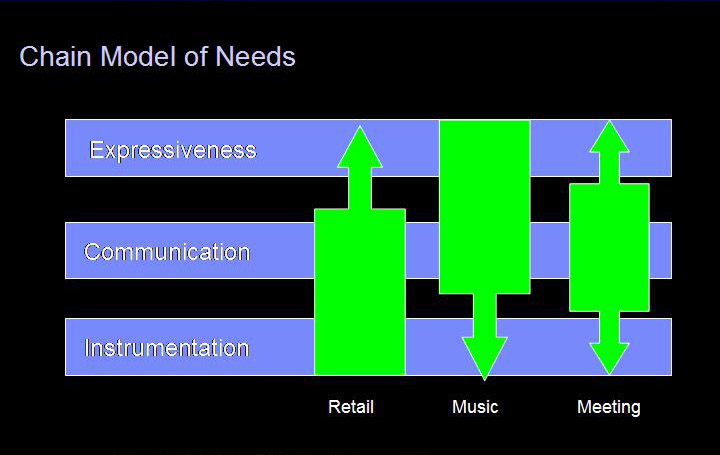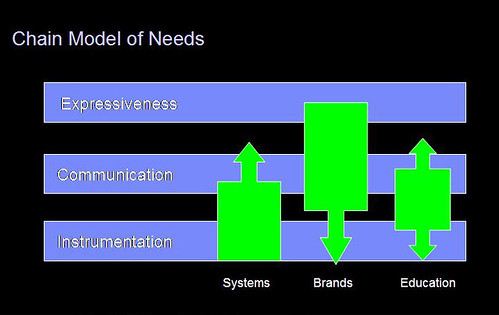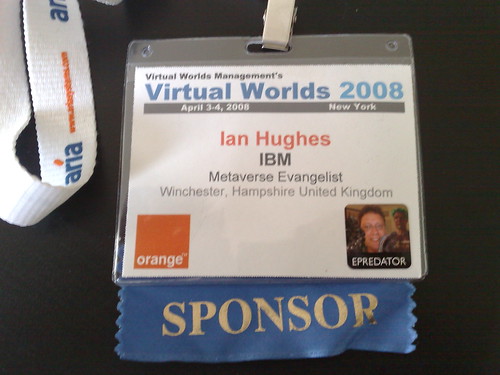It would be impossible to not do a post about Grand Theft Auto IV here. So here we go. Not everyone who has come to virtual worlds and metaverse, nor everyone who is a tech geek is a gamer. In fact it seems that many tech geeks simply are not gamers at all. Personally I am a gamer. I have been proud to same I am for a good few years now, though when I started work it was not the sort of thing people put on their CV.

To many people video games are still simplistic mindless shooting platforms. Its fair to say there are a few of them! That being the case sometimes it is nice to just spark up a game for your own enjoyment and challenge, something old school patterns, levels, speed, reactions and knowing full well in the end the machine will win.
In the late 90’s though we started to see the rise of the LAN party. Online gaming, but local and fast. We often (in our slightly off the beaten track way) used to play team games after hours here in Hursley. This is where the exprience came, for me atleast, in understanding that you can learn a lot about people, form bonds, freindships, explore rivalrys etc in a immersive 3d environment (Quake, Unreal and Half-Life(team fortress) back then.
Knowing that there were benefits in a business context for team bonding, but seeing that fragging people requires both technical proficiency in puppeting your armour clad gun wielding avatar and a certain type of competitive, show off nature that not everyone comes to naturally in an at work environment I spent time looking for things that could harness the essence of the LAN party yet not need this extreme aggression.
It was knowing about the gaming gene being fired in my body when I start to experience things that warned me off some types of application. (That is not to say gaming is not important but there is a trigger I feel when I get a game buzz). It was of course Second Life that filled that void two years ago. The gaming gene did not fire, the communication, blogging, web2.0 sharing, business opportunities, technology architecture and social shange genes that ignited.
Now though people are becoming even more aware of the power of high end games. People who have never bothered with a console or stepped paste mindsweeper are starting to pay attention to how the games industry represents physics, the world and also how they make money.
With the release of GTAI V Rockstar games have produced a fantasticly detailed, engaging virtual world, a sandbox to explore. The sheer size and depth of the model of Liberty City is still astounding. This was of course a solitary experience in all the previous versions. Your 360 or PS3 would be rendering the city, telling the story. The latter of which you can choose to ignore as you set of to create your own goals to personal “I wonder what would happen if” questions. Last night though GTA IV crossed a line of experience. Both Roo and I ended up online in our respective houses and then descended into multiplayer games of GTA.
Multiplayer games as in up to 16 players, the player count is not massive but the playground of the city is. Whilst most games need a structure, a goal, capture the flag, remove the boss etc. there was a feeling that hit me that this model we were in did not just fire my gaming gene. At various points one of us would borrow a car (or a bike) and the other would hop in, and then just go exploring. A collaborative sandbox.
Games have had collaborative vehicles before, but I dont think they have had the same depth of interaction in the setting they are placed in. They have not felt quite like this.
Now clearly the subject matter of GTAIV does not help people get over the “games are about violence”, it is about business though (albeit a slightly unsavoury one).
If the games are starting to fire my personal set of non gaming genes it is only a matter of time before some new generations of staggering interactions start to occur.
All that said, GTA IV is a stunning game. The humour, the detail, the involvement, the internet cafe’s with its own made up embedded web, even the voice acting is tremendous (something that does not get said about games very often). It is also in the public conciousness, so now people may start to join some mental dots about game environments and metaverses whilst sitting watching,playing or reading about GTA IV on PS3’s and Xbox 360’s (both with embedded IBM chips and hardware in them.)
Monthly Archives: April 2008
Augmented Reality N95 style – hackday tea
We had a Hackday in IBM today, it was the 5th year of having a day when people just find a project and blitz it for a day.
The aim is not always completion, but starting and sharing.
I decided to try a proof of concept around augmented reality on my N95 using Python.
Here is a screen shot of something that I counted as a result. The next steps are to allow for greater movement in the heads up display. I needed these first steps of overlaying data first though
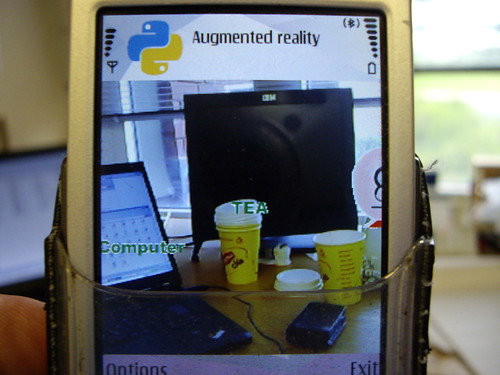
I have to say I was quite pleased for a few hours mashing and hacking and a few hours prep.
Streaming Second Life to a 3g phone – Vollee
This video has just surfaced from Vollee showing the SL experience on a 3g Phone. This service is one that instead of trying to make the phone do all the work it renders the client remotely and streams it to you as video which you then interact with remotely. This same principle was the one that was used to show ActiveWorlds on the phone at the VW 2008 conference the other week. It also is the same principle that the PS3/PSP use to interact across wireless networks anywhere in the world. Where your PS3 acts as a rendering server for the PSP client to view photos, videos and play some older emulated games.
Business Interaction in Metaverses – “Reverse ICE” model to map against
I believe that many people are still looking at metaverses and not considering the wide spectrum of modes that the subject covers. Some of the potential reasons given for fear or suspicion are directed at the wrong end of the spectrum and hide the other deeper benefits that may be more comfortable for those people who are objecting.
I wanted to have some sort of spectrum that I could apply various business ideas, where already the business need exists but to be able to identify the key component that differs and hence some benefit can be seen or inferred or discovered.
The first element to this is a three layer model of where metaverses fit in and work
accidentally this is ECI, or ICE if reversed hence the title “Reverse ICE”
1. Expressiveness
This refers to the way that many early adopters and web2.0 people have come to metaverses. Just as Blogs, flickr, last.fm, twitter etc all allow a degree of personal expression the virtual worlds extend that expressiveness, how you dress, where you hang out, who you know, what you build, events you are seen to attend.
It is this expressiveness that causes the biggest shock to people who are not in the subset of people who do this. it is not wrong to not want to be expressive, but it can be viewed as the frivolous end of all this and the one that needs to be controlled in a business sense.
Expressiveness is the least measurable benefit, yet the one anecdotally we all benefit from the most. “I dont want to mess around creating an avatar” etc is a valid concern in the adoption or virtual worlds. It is also the one that is not seen quite so much in web1.0 where company information sites, shops etc are not about the users involvment in quite the same way.
2. Communication
This layer refers to the fact that metaverses are a communication medium, as are websites, blogs, powerpoint. User generated content whilst also blending with 1. above also are there as a commnuication vehicle. A picture says a thousand works so does a metaverse location in 3d say a million? We need to communicate in business with one another and around projects, with customers etc. This communication layer exists already in a variety of forms some more “efficient” than others
3. Instrumentation
This layer is the most comfortable for a company and in particular a large corporate. Instrumentation refers to the fact that there are things going on somewhere, in a business, in financial results, in a disaster situation etc that are all part of the information stack that drive business decisions. In many senses this is SOA(Service Orientated Architecture). The inbound and outbound services (whether technical implementations or not) are things about the business world, or social world that act as data, facts and decisions implemented.
With these three areas overlap I believe we can map certain types of business problem and see the parts that are newer, or brighter or more enhanced by virtual worlds or other solutions.
a. Retail
I would suggest that when retail is boiled down to having to shift product to customers the business flow would be as follows.
Instrumentation (How much have I got/What price to make profit) —-> Communication (advertizing, shops, salesforce) —-> Expressiveness (Engaging with a customer set, emotional involvement with a brand, customer loyalty and championing)
In pure web terms Instrumentation to Communication is clear, its putting products out there, simple clicks to buy. A small layer of expressiveness and brand engagement occurs, usually though other channels are used. Lifestyle, tv etc. Virtual Worlds offer a richer degree of expressiveness in that consumers may engage with the brand product, with each other and with members of the organization selling the product. The degree that this is needed depends on the product but the richness and depth comes from going past communication and engaging in the human need for expression. many brands already do this in several ways so as a channel do this more or better it would appear to fit.
b. Music/Art
I made this separate from retail in order to highlight that some industries and business do not flow in the same direction as the first examples.
Music, and examples of how MTV are operating at the moment in the web2.0/virtual world space follow a different pattern.
It starts with expressiveness (having an message, a feeling, a song) —-> this moves to be communicated in a variety of ways building a fan base. A loop occurs in that the fan base engages in expressiveness and commnuication too —> in business terms this then moves to instrumentation, selling records, songs, downloads, merchandise (the realm of the record company)
Virtual worlds are used to engages at the expressiveness stage, bands perform, fans attend bypassing some of the need for co-location. Successful bands become “mainstream” and appear on MTV an get record deals.
c. Business Meetings
This example is interesting as it starts in the middle to some extent.
Communication (There is a need to commnuicate/decide/inform/share in a formal sense) —> This leads to needing instrumentation from the business, data, results, powerpoints, evidence, business dashboard, KPI’s, threats from competitors. In regular business it might be considered that that is where the seriousness is, Just Communication and Data. However meetings of any sort have a degree of expressiveness. Business relationships exists, politics exist. awareness of others and understanding motivations and positions exists. Leadership is required. In most electronic media we use this is the thing we filter the most with phones, pure text etc. Some people only need this, only need th bare minimum (potentially because they already have a deeper insight) others need more immersion with other members of any meeting. Hence meeting face to face allows for this expressiveness (even it that is a poker face) to occur. Other electronic media turn down the detail. Virtual worlds allow for degrees of expression. The balance comes as a barrier to entry problem that some people can work a virtual room very well, other feel at a disadvantage. This is a threat to many people who have great social skills in real life but then feel they cannot translate them to any other platform or technology. I think this will dissappear over time but is a cultural problem.
Making the expresiveness that the more skilled communicators in real life need, easier to apply to the virtual world, and pulling in the instrumentation in an easier SOA fashion and delivering the answers out again are where we can make a big difference as a company I think.
d. System architecture/Data Centres/Buildings
This is a more pure mirror world/paraverse example.
This is about visualizing the data from instrumentation, where are my software elements deployed, which machine is not working, where are the power condiuts. Taking a location or state of a business or a chemical model and rendering it in 3d where appropriate does not really have to involve people or avatars. This is business/it dashboard territory. However in moving towards the layer of communication, to get the message across, drawing this in an immersive way to be experienced is what we try and do all the time. UML diagrams, design drawings, blueprints etc.
The interesting element again is that this is probably a very comfortable place for many technologists to consider things. It does not need a great layer of expression to be applied. However that expression can be there and can be used in a virtual worlds. Imagine two architects in a room discussing a design they will draw on boards, point, argue, agree, pull rank etc. This can and will also happen in a virtual world where such devices are available to express themselves. That expression does not have to be weird and cool clothing, or funky avatars, but pointing, moving, altering the environment, altering anothers point of view to show the effect of change.
e. Brand engagement is usually more about people dealing with levels of expression, in real life wearing the t-shirt, driving the car, mentioning the product in a blog post. I think it speaks less to instrumentation, though clearly if instrumentation is bottom line figures and business then it needs to. It just feel more decoupled. It may be the case in virtual worlds presence too. Enagage the passionate users, be part of the community first, not a hard and fast advertising of presence.
f. Education. This is traditional education, class, facts, teachers, pupils. Clearly this needs to deal with expressiveness, and it may be that the engagement that occurs with students wanting to be part of something is why we see such a growth in serious games.
As you can see I hope the normal expressive worries are often placed before the more solid business reasons of communication and instrumentation. We can engage people in those other layers without them having to worry about the expressive, but the expressive will come over time.
Many of us as early adopters flow around all these layers all the time, but a more directed approach for some may make it easier to accept. This may get over any mental barrier to adoption whilst we also need to sort out the technical barriers to adoption and make it easy to engage and for people to feel comfortable in that engagement.
Also this is by no means a hard and fast classification. It merely aims to place some elements of familiar business into some sort of context. A good business leader will more than likely be a strong personality and very expressive when rallying their people, whether that is for motivation or to deliver solid business messages to a wider audience. Those that seek to lock down this expressiveness and claim that business, politics etc are only a “serious” platform requiring only “serious” interactions may need to realize this is not a binary domain.
It seems that metaverse in particular, even more so than the text and pictures of the blog, challenge peoples notions of expressiveness. There may be a short term power base in business of people more akin to the traditional social networks and performance platforms, doing lunch, playing golf etc.
We had a good session recently discussing these points and it appears to work as a model for helping translate some of the business ideas. It is a high level model, with a lot of flexibility to explain many things. Being able to make a distinction between a type of business and the types of reasons for not doing certain enagegments is much mroe important now as people are gaining a degree of understanding as people as to why metaverses work, but now need to see where they fit in specific business areas.
More eightbar everywhere – on the Wii this time
This is a slight tangent(but thats what we do), but as we tend to make eightbar things in lots of virtual places I finally got around to an eightbar Mii on the Wii.

Roo has also started using the 8bar clan tag in call of duty 4 on the 360 as you can see here
I also did my own version of a Predator Mii here
We won an IBM Baffler for eightbar
In a prestigous awards ceremony held in Hursley this afternoon the results of the IBM wide voting in various categories for blogs and social media were announced. Eightbar won the category of “Best IBM related external blog”. Props go to James Taylor for getting this whole thing going, but most of all thanks to all who voted.
We should also thank all our other readers not in IBM who have taken an interest in what we have had to say over the years on eightbar, in particular the whole metaverse/secondlife/virtual worlds crews out there. (…Insert any suitable gushing oscar acceptence speech in here that is your personal favourite)
What do we win for this then? Well as its by the people for the people its really the prestige and knowing that a whole host of collegues have appreciated what we have been going on about and the way we have gone about it.
To mark the win we are getting a share of some fantastic Moo Stickers (You can tell our fellow eightbar Andy Piper (sometimes Moo salesman and evangelist has been involved too)). Also special thanks go to Daz as he is the one paying for the hosting and doing the sys admin on all this too.
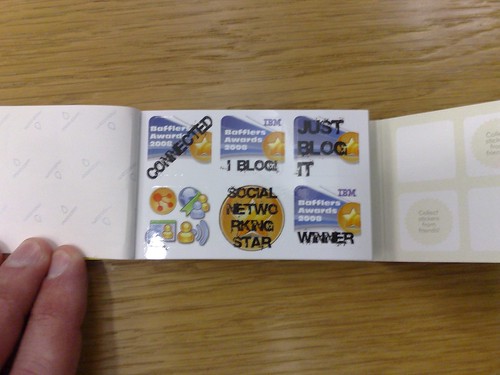
I still keep telling people Web 2 is Web Do, you have to just have a go and see where these things take you.
Mockery, Flattery, either way the Late Show is funny
The more we see virtual worlds appear in mainstream commentary the more we realize how deeply they are seeping into society. Reporting on congressional hearings shows some degree of questioning and depth in the news not just sensationalism and fear. That could be some high-brow way of saying they were making fun of “us” and we don’t like it. However, this is great and we do :-).
The Daily Show is well respected over this side of the pond too. (Thanks to fellow eightbar Chris Howard in Ireland for sending the link this morning)
My picks of the Virtual Worlds 2008 New York show
Virtual Worlds 2008 has been a very intense experience, both from seeing just the sheer amount of growth in the industry, seeing all my colleagues as deeply immersed as I am and seeing some very cool new things emerge.
I have three picks of the show that stood out for me personally. As well as being virtual world technologies they also have two other things on common. Two are from Australia (an odd coincidence but I like linkages like this) the other is that they are middleware related, they represent a flexible and more diverse approach to virtual worlds that allows us to break some of the patterns we have already become used too.
Those picks are
The first pick is Mycosm. This company came out of stealth at the show. I know they gave demos to a few colleagues and there was a general buzz. As I investigate more I will share what they actually do. In the demos and conversations I saw a very flexible system allowing for all sorts of objects and types to be treated in a uniform manner, 3d object import, painting with brushes that are also composite objects, meta data properties on objects such as friction, rag doll physics, rich avatars, a very rich rendering on the front end overall. All this is very good but also under the covers it appears to have a more modular approach to functions. Being able to run peer to peer or centralized (or a mix and match) due to the nature of the underlying services model. Being able to operate with web services which for me means being able to link with existing business systems as well as the web2.0 world.
Being able to take advantage of a richer game front end but drive it with services starts to fit more with mirror worlds and with simulations. I am looking forward to delving deeper and seeing where this one can go.
The second is Vastpark. This solution is also middleware. Its distinguishing elements are based around the consumption of services to create virtual worlds. The interesting elements around this are the use of a markup language to describe scenes. It is also interesting that its pulling of objects from other repositories appears to be more Service Oriented Architecture based(SOA). Delivering a markup can mean that assets are referred to elsewhere such as turbosquid. Being able to place function or data elsewhere and have it pulled together in a service compositional way opens up interoperability in the correct fashion, not just pure import export but live. The Vastpark site also refers to existing forming standards as being relevant to them, opensocial, metawss and imml. These to me are all good signs.
The third and final pick is the Multiverse proof of concept of a full 3d world and 2.5d flash client both interface to work talking to the same server. The ability to use different platforms, either through choice or through need, yet have people respond to one another and benefit from the virtual worlds is very important. To see Multiverse showing the blending will help people consider this path and not a generic one platform answer.
I also have to mention the IBM demonstrations, but it would be wrong for me to pick those as favourites.
- Craig demonstrating the Second Life instances running on our blade servers
- The IQ team demonstrating our Metaverse integrated with our enterprise services
- Peter showing the lenticular 3d monitor running a Second Life client talking to OpenSimulator
- Michael showing Activeworlds running on a 3g enabled mobile phone connected to other users on richer clients.
This is not to say there were not other significant things, the keynotes and panels surfaced a few things. Such as in Roo’s panel Christian from Millions Of Us mentioning that MOU are doing the builds for Sony Home and the backchannel and post conference party conversations which give another insight into the industry.
I hope that as we get more take up at these events we also start to move to representing them virtually too. Lots of people were not able to attend, but because there are so many diverse platforms and we don’t have interoperability yet we tended to stick to twitter as an information channel for people. Capturing atmosphere and buzz to mirror events is an interesting challenge, but I am guessing that the people attending and presenting at the show are best placed to solve it for ourselves and others.
Industry growth in Virtual Worlds
The Virtual Worlds 2008 conference here in New York was significantly bigger in exhibitors and attendees from last years one at the same time of year. Last year there were 2 small office rooms with about 10 exhibitors including IBM. This year the trade floor was somewhat bigger. This is a quick wander around just to help share some of the buzz and atmosphere.
Two years ago was my rez day for Second Life as epredator potato. I am still amazed at how quickly we have all progressed and the take up and interest is still growing. we know everything is not solved but evolution has to start somewhere. Some of the new things we saw at the show (longer posts coming on that) started to feel like a new generation or cycle was starting as VC funded firms come out of stealth. There are a few that need to turn off their predator hunting cloaks too.
Summary of social networks panel at VW08
I moderated a panel on virtual worlds, games and social networks at the Virtual Worlds 2008 conference today. I recently put out a request for questions here on Eightbar, and got a great response. Here are my (very poor and woefully incomplete) recollections of the event. I’m hoping to get a copy of the audio from the event organizers, which will help me flesh this out For now…
My three co-panelists introduced themselves- Christian Lassonde – President & Co Founder, Millions of Us
- Susan Panico – Senior Director, Playstation Network, Sony
- Sean Ryan – CEO, Meez
Susan described the attraction of worlds created “for gamers by gamers” so I pressed her on whether Home is going to include user generated content. (When Corey Bridges spoke at SXSW, he mentioned that in the late 90s, if you’d asked people who will be the biggest content producers on the web, people might have guessed ‘Disney’, or other big entertainment brands, and that this turns out not to have been the case. In quite a big way. The creators of the web are everyday people. Does the mentality of user-generated content have any space in the world of Home? (I also mentioned, in a hat-tip to timdp’s question that she should explain it in terms of what will make Home ‘sticky and compulsive’). Susan conceded that while the experiences would be participatory and social, the content is not going to be user-generated. Christian later revealed that Millions of Us are working with Sony on Home (which was new news to me!)
I asked a very summary version of David Orban’s question (I probably didn’t do it justice, but I pointed out that virtual worlds and games are generally synchronous and realtime, while web based social networks are largely asynchronous. What implications does this have for the future of virtual worlds and social networks?) Everyone agreed that social networks are generally asynchronous, and games are generally synchronous, and all predicated that virtual worlds were bound to become more like social networks in the future. Giff Constable ask a question to clarify that synchronous things don’t tend to happen in asynchronous spaces (not currently many examples of this in existing social networks) but hinted that increased presence information (“currently online”) might gradually augment what we see now (replay, ghost data to simulate synchronous activity in an asynchronous space). I should have pushed harder on this point, because there was a big gap between where everyone agreed we are now and where they all agreed we would obviously end up. I asked about walled gardens.(My friend kybernetikos wanted me to ask this question: Walled gardens have failed (spectacularly and famously) on the web. Yet people are making walled gardens in the fields of games, social networks AND virtual worlds?)
Christian said that he didn’t expect this to chance in the near future (though mentioned that perhaps in the long term things may be more open). In the short term, he described a business reality in which people have no incentive to help people migrate into a competitive. Question from the audience re virtual worlds for learning and education.
Both Sean and Christian agreed with each other that education was not a big sector at the moment. I chipped in with the point that education and business are not mutually exclusive, and that there are lots of ongoing projects with education and training for business. Question from the audience about networks which extend beyond one world/game, in which you register your avatar/user for multiple social spaces and share reputation and status in multiple places (including Myrl.com).
Christian pointed out that these had been around for a while, and most have fallen away. Final question from the audience on where is this stuff going in 5 years.
Christian says 5 years is particularly hard (1 year is easy. 50/100 years isn’t too bad. 5 years, someone will hold you to it.)
Pretty much consensus from the panel that virtual worlds are going to be big. Maybe we won’t talk about social networks and virtual worlds as separate things. I predicted that 2D content will still be around for a very long time (in addition to much more ubiquitous 3D stuff where it makes sense), and also mentioning that I’d been surprised not to see more Augmented Reality at this conference and to look out for it in the next few years.

